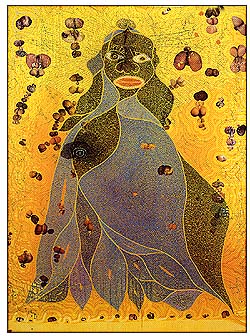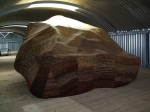 When I was last in New York, I came across a woman sitting on a chair in the middle of the road, winding a huge ball of yarn around her head. This was art- of course! On the same street (on just an ordinary weekday), I saw half a bicycle supposedly sinking into the pavement, and a children’s playground inhabited by stuffed gorilla suits and spiderman outfits. I think there was a Santa Claus on the swing.
When I was last in New York, I came across a woman sitting on a chair in the middle of the road, winding a huge ball of yarn around her head. This was art- of course! On the same street (on just an ordinary weekday), I saw half a bicycle supposedly sinking into the pavement, and a children’s playground inhabited by stuffed gorilla suits and spiderman outfits. I think there was a Santa Claus on the swing.
All in a day’s work for an artist down in Billyburg, I guess. But it’s not the sort of thing that always translates well. Imagine that same woman on the streets of London. She’d probably get moved for health and safety reasons. Or for getting in the way of oncoming traffic.
In any case, what people really want to see is life. The trans-Atlantic symbiosis is not about being clever. It’s not even necessarily about art, or fashion. It is, sometimes (often), about competition. But mostly it’s about two divided siblings wanting to reconnect. The thing is, when you’re standing and staring at an installation or show in the street, it’s rare that you can really break through the dividing screen between life and art. Londoners have been enchanted by New Yorkers for decades, and vice versa. I think it’s pure curiosity.
Manhattan in the ’60s was the original hotbed of collaboration- think New York School of Painters, New York Poets, the Beat generation and then, of course, Warhol’s Factory. Since then, the concept of collaboration has massively expanded. Interaction doesn’t need, necessarily, to be contained in a finite space. It can span an ocean. I think the reason we’re so intrigued by Warhol’s Factory is that it marked an era when people realised that barriers of artistic genre and form could be completely dissolved. Music, art, fashion and culture came together in one uncompromised, uncontrolled fusion- and there is no going back from the shift. It shook so far as to reach even our own stiff upper lips. It’s a good thing we’ve got the images to help us remember.
The late Nat Finkelstein, one of the most respected photojournalists of modern times, played a huge part in this. His work provides a pervasive visual narrative for these years, which were creatively formative not just for New York but for the entire Western world. Finkelstein’s photos are on display at Idea Generation Gallery in Shoreditch at the moment- but not for long. It’s the way of the modern metropolitan not to hang around.
The opening of the exhibition was an amazing night, a true case of worlds colliding, and in the best possible way. Finkelstein’s widow, Elizabeth, was flown all the way from the Big Apple to the Big Smoke by Metrotwin, but found herself quite at home among Nat’s old posse and his iconic photographs.
This stunning retrospective brings together Finkelstein’s diverse portfolio: from Factory scenes to civil rights and anti-war protests of mid-60s America, from intimate portraiture to a continuing exploration of the subcultures of 80s and 90s New York. The scenes- the Factory, protests and subcultures- interlaced by the recognisable glamour of Edie Sedgwick, Duchamp, Dylan and Warhol, capture the spirit of the age. Finkelstein doesn’t himself ever feature in front of the camera – he was too busy recording the life he saw. What you see is the world perceived through his eyes. And so this show is really one not to be missed.
“When all is said and done, when everything is gone, the photograph is what’s going to remain.
The photographer is the producer of history.” Nat Finkelstein
Nat Finkelstein: From One Extreme to the Other, is open until the 14th February.











